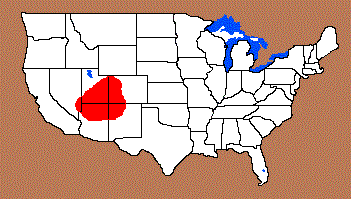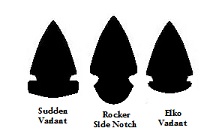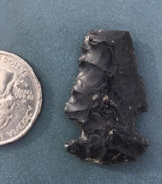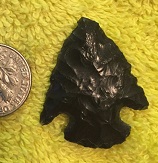Name Details:
Named By: Jesse Jennings
Named For:
Date Identified: 1980
Type Site: Cowboy Cave (42Wn420), Wayne County, Utah
Rocker
(Elko Variant)
Cluster:
Date:
Cultural Period:
3,500 - 1,400 B.P.
Late to Transitional Archaic
Neoglacial to Little Ice Age
Glacial Period:
Culture:
Outline is Representative of Size and Shape:

Side
Notch

Corner Notch
Description of Physical Characteristics and Flaking Pattern:
This is a medium ovoid to triangular point with an elliptical cross section. The blade is
primarily excurvate, but may vary to straight with the widest part of the blade being above the shoulder. Parallel U-shaped notches enter low to the corners of the preform forming a shoulder that may
vary from horizontal to being slightly barbed. The stem is expanded to expanding with a convex base. The stem is short in relationship to the Rocker Side Notch type. This point has a
random flaking pattern.
Size Measurements: Total Length -
24 to 55 mm, Stem Length - 9 to 13 mm,
Blade Width - 15 to 24 mm, Neck Width - 10 to 19 mm, Stem Width - 13 to 42 mm, Thickness 4 to 9 mm
This type is found in relations to other Elko type point while the Rocker Side Notch is found in relation to Northern Side Notch and Sudden Side Notch points.
Distribution:
Distribution Comments:
This point is primarily found in the Great Basin and in to the Colorado Plateau.

Additional Comments:
Homer (1980) first described the Rocker Side Notch as a wide point created from an ovate preform with notches placed on, or close to the corner of the preform creating a short hafting
region. This description lead to many people lumping all convex base point into the Sudden type due to the lack of typological difference (Justice, 2002). This has lead to many different point type being
clumped into a type that is not supported by the key characteristics of that type. Sudden Side Notches are distinguished by U-shaped notches being place high on the preform forming a large square basal area.
Novotny (2007) re-defined the Rocker type by two defining features, first is U-shaped notches high on ovate preform, and second is long well rounded stems. This left two different style points previously
labeled as Rocker falling outside this definition. First is a Sudden variant which has high U-shaped notches with l large square basal area and a convex base. The second is the examples recovered from
Cowboy Cave by Jennings in 1980. Two Rocker Side Notch points were found, but they were fund in levels with Elko type points which are considered much newer than typical Rocker points. Also Rocker points
have a much smaller stem than described by Novotny. These two examples tend to represent an Elko variant more than a true Rocker type point. Justice (2002), points out that many Elko variants have been
typed as Rocker points which are much older than Elko type points. The Rocker type has been divided into three types. First is the Rocker Side Notch as described by Novotny. Second is a Rocker
Sudden variant, and third is a Rocker Elko variant.
This is a variant of the Elko type and may be
found within the same distribution as the Elko
type. In the northern distributions this type
has many of
the overlapping characteristics
of the Hells Canyon
type.

Pictures:
Side Notch

Corner Notch


Other points in this Cluster:
Point Validity: Variant Type
Jennings was a renowned anthropologist and professor at the University of Utah. He was considered a foremost expert on Great Basin anthropology. This type was included in the Rocker Side Notch type. This is a variant of the Elko type which is a newer type than the Rocker type. This is considered a variant
type.
.
Age Details:
Pictures Provided By:
Jordan Lammert
References: (See Reference Page, Entry Number):
10, 12, 17, 30, 37, W11, W18
Rocker Projectile Point, Rocker Arrowhead







